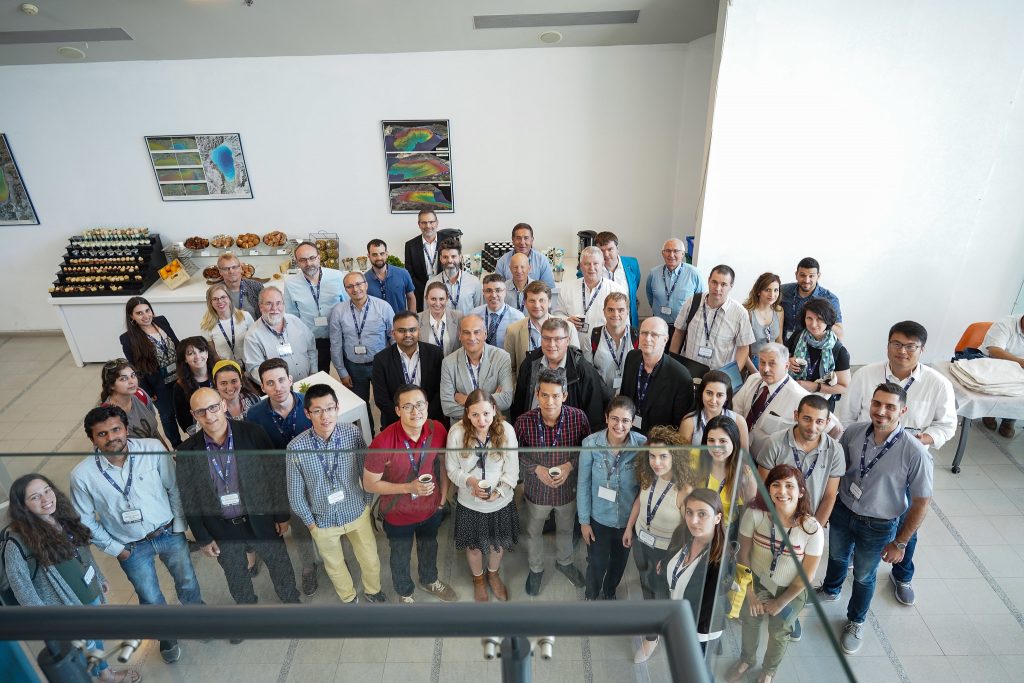Dressing for Health
Wearable Devices for Medical Diagnosis: An International Conference at the Technion
On May 13-14, the First International Conference on Wearable Devices for Medical Diagnosis was held at the Technion–Israel Institute of Technology in Haifa. Attended by industry and academic personnel from all over the world, the conference was led by Professor Hossam Haick, head of the Nanomaterial-based Devices Laboratory at the Wolfson Chemical Engineering Faculty and a member of the Russell Berrie Nanotechnology Institute (RBNI).

Conference participants
“The field of wearable devices has been gaining momentum in recent years, and today there are wearable diagnostic technologies such as smart watches and smart clothes,” said Prof. Haick. “But they are often inaccurate or limited in the variety of possible applications. The way to leapfrog ahead in this area is biochemical sensing – precise monitoring of physiological conditions based on chemical monitoring of the skin and of various organs. We aim to produce non-invasive – or almost non-invasive – monitoring technologies and to connect the sensors to IOT (Internet of Things) infrastructures, so that multiple data can be collected and analyzed electronically for the benefit of the medical staff.”
Conference lectures focused on a wide range of topics that included pulmonary function monitoring, cardiac activity monitoring, the development of medical monitoring sensors, and innovative skin patches for rapid and inexpensive monitoring of tuberculosis.
Dr. Andrey Broisman, scientific director of engineering at the Ministry of Science and Technology, greeted the conference participants and presented the Ministry’s support channels for Israeli science and international cooperation.
The opening lectures were delivered by Prof. Kenneth Suslick of the University of Illinois and Prof. Corrado di Natale of the University of Rome. Prof. Suslick presented the solutions developed in the last decade in the field of sensors that are likely to play a major role in the diagnosis of diseases by wearable technologies. These include inexpensive sensors that decompose, as well as ones that mimic the natural olfactory system and provide a visual output that describes the object’s odor properties.
“In fact, we developed a system that identifies the ‘molecular fingerprint’ of odors, enabling accurate electronic mapping of the components of odor and monitors toxic gases and spoiled food,” said Prof. Suslick. “They can distinguish among different types of coffee, whiskey, etc. In medicine, we have been able to perform continuous monitoring over time and identify biological markers of heart and kidney disease, and no less importantly, monitor bacterial resistance to medications.”
Prof. di Natale described his approach to electronic monitoring of biochemical materials related to human health. This approach, “combinatorial selectivity,” simulates the natural system of human smell sensing. “A person has about 350 smell sensors that can differentiate among millions of sources of odors,” he said. “Inspired by the human olfactory system, we have developed a technology that makes it possible for us to monitor malaria and cancer and also to distinguish among different types of cancers.”
Ph.D. candidate Muhammad Khatib of the Haick Research Group presented innovative technology in the world of wearable monitoring – flexible sensing systems that can repair themselves.
“When we speak about wearable equipment,” said Mr. Khatib, “we want systems that can stretch and are flexible, but they also must be self-correcting, which we developed with inspiration from nature and the support of the Bill and Melinda Gates Foundation.”
“Animals have the ability to repair damaged tissues in their body, and that is the characteristic that we want to copy,” Mr . Khatib continued. “What we have developed is a polymer-based transistor that can repair itself not only structurally and mechanically, but also in terms of its electrical properties. After we saw that it succeeded in fixing itself when we cut it, we repeated it in various types of water, even seawater, and found that it quickly repairs itself and recovers its previous capabilities. The significance of this is that these devices can work in the damp environment of biological tissue, on sweaty skin, and so forth.”.
The conference was held at a unique time in terms of the international activities of the Nanomaterial-Based Devices Lab, namely the completion of the SniffPhone consortium and the opening of two new clusters: VOGAS and A-Patch. The three consortia are part of the Horizon 2020 program of the European Union, which allocated a total amount of 18 million euro to them.
The SniffPhone system is based on a smartphone-related technology for speedy diagnosis of cancer and other diseases based on the patient’s breath. The new hardware is a system the size of a smartphone into which the patient exhales (without the need to hold it directly on the mouth). The data are transmitted via mobile phone to the “cloud” in which the information is analyzed and the results are transmitted to the attending physician. Vogas, a consortium of academics and industry partners from Europe and Latin America, is continuing the same project for eventual clinical implementation.
A-Patch, a consortium of researchers from academia, hospitals, and various companies, is working for the continued development of a cheap and reliable patch for tuberculosis (TB) surveillance. TB, one of the world’s most infectious and deadly diseases, accounts for about 1.8 million deaths each year.
The current diagnostic method, a skin test, requires laboratory services and takes a long time. The skin test is a process that involves injecting a substance (tuberculin) into one of the arms, testing the skin reaction after a few days and repeating the whole process in the other arm two weeks later. The development on which the new consortium works is a small, inexpensive, disposable diagnostic sticker that will cost about $1.50. A multiple-use sticker will cost about twice as much. The label reads the patient’s physiological data and attaches it to a smartphone. This data is then transferred to the cloud for analysis and diagnosis by a physician. The Bill and Melinda Gates Foundation has been involved with the project for several years.


